
|
|
|
Search our site
Check these out    Do you have an entertaining or useful blog or personal website? If you'd like to see it listed here, send the URL to leon@pawneerock.org. AnnouncementsGive us your Pawnee Rock news, and we'll spread the word. |
Too Long in the WindWarning: The following contains opinions and ideas. Some memories may be accurate. -- Leon Unruh April 2006Death and survival[April 30] Isn't it reassuring that once in a while, when your life absolutely depends on it, you're able to do the absolutely right thing? Sometimes it's a matter of doing the right thing; other times it's enough to avoid doing the wrong thing. Four years ago last fall, I was walking with my family along a salmon stream up the valley where we live. The path was lined with tall dry grass, so we and the grizzly bear didn't see each other until the bear came around a corner about 20 yards ahead of us. Sudden or threatening moves -- such as looking the bear in the eyes -- could bring bloody mayhem. My wife and two young sons graciously put me between themselves and the bear, and we backtracked about 100 yards until we were around the corner away from the stream and could flee without embarrassment. Thirteen years ago this summer, about a year after Mount Spurr volcano erupted, a couple of friends and I decided we'd climb to the crater. We got advice from a vulcanologist, hired a floatplane to land us nearby, and were dropped off on a sandy beach at Lake Chakachamna. We would be out of contact for 40 hours until our pilot came back, weather permitting. We put on our bulky packs. Our first steps took us past a disused cabin scarred by bear claws, and we clambered across a glacier and into an alder forest so thick we had to use bear trails to get through it. We realized after eight or nine hours that we wouldn't make our goal. We turned around, heading back across the glacier's moraine, which is the silt, gravel and rocks a glacier pushes up in its path. Our route took us up a 40-foot cliff of dirt. Thirty feet up, following the two others, I got stuck, spread-eagled. Only by not moving at all was I able to avoid disrupting the dirt and falling onto the rocks. My friends crept down with ropes and rescued me. My training for not dying early came from Pawnee Rock. Three practice sessions come to mind. One was avoiding a bull that didn't want a kid with a fishing pole to walk across its pasture. That's not a big deal -- we've all done that. Then there was a Boy Scout camping trip to Lake Wilson. Troop 444 took over a hilltop picnic site with a concrete roof, pulling our El Camino and car up close to block the southwest wind. We unloaded our 12-man Navy surplus life raft and leaned it against the vehicles so we would be ready to go boating the next morning. Our arrival, on a muggy spring day, was followed by a night of quickly arising thunderstorms and fearsome lightning. The winds were terrible, and it seemed that not only we but also our raft would be blown to Russell. Scoutmaster Ron Stark got each of us -- we shook with fear but remembered our knots -- to tie a section of the raft to the metal parts of the picnic tables to protect us from the rain and wind. The next day we found that the area had been visited by three tornadoes. At the time we were happy just to have not been fried by lightning before we were fried by the sun. Sometimes you get into trouble so bad that only luck or clear thinking can get you out. Having decided we liked Lake Wilson so much, our troop made another trip that summer, this time camping on the southern beach near a stand of small cottonwoods and willows. We boated and swam and fished, then ate our beans and marshmallows and slid into our bags to sleep under a half-moon sky. Around midnight I heard rustling near my head. I must have been fairly tired, because all I did was nudge Alvin Carris and say, "Alvin, look. There's a skunk with its head in my bean can." And we went back to sleep. Whether that was luck or clear thinking, I can't say, but it was the absolutely right thing to do. Hair on the floor[April 29] There comes a time in every young man's life for his first trip to the barbershop. For me, it was in high school. My mom had been our family barber forever, possibly because Pawnee Rock didn't have a barber anymore and probably because it was cheaper that way. But when I was a junior in high school, Mom had had enough and sent me to Larned to the barbershop on Broadway. It was a big day: Drive to Larned by myself for only the second or third time, angle park downtown on a rainy Saturday morning, and walk into a barbershop. What do I ask for? Do I pay first? Will the barber cut me? Will it be like the barbershop in Blondie where Dagwood gets a bad cut? Fortunately, the barber was an old hand at nervous new kids and things went well. It was fun playing grown-up and getting personal attention from somebody besides the doctor and dentist. The $3 cut of the 1970s has given way to the $15 cut of the 2000s, so I'm back to getting haircuts at home. My wife whips our sons and me through the kitchen clippery in an hour or so -- one chair, wait your turn. But the adventures of my youth aren't forgotten. Both boys got their first real barbershop haircuts before they were 5. Fishing is believing[April 27] Standing on the gravel bed of Willow Creek, his red-and-yellow rainboots shiny in the clear fast water, Sam cast his spinner about 20 feet. My 8-year-old believed there was a salmon waiting for him. This was his first time fishing for salmon. He didn't know anything about hooking big fish, playing fish, landing fish. He knew only that if he cast, he'd catch a fish because his dad told him he could try. . . . When I was a youngster in Pawnee Rock, I was a fishing fanatic. I fished at least once a week, subscribed to Outdoor Life and Field & Stream, and knew every species of fish across the United States. I believed everything I read. One magazine article told me I could fashion my own lures by trimming the handle off a plastic spoon and melting a couple of holes into the spoon for the hook and swivel, so I did. My parents gave in to my begging one spring evening after a big rain, and we parked at the bridge over Ash Creek near the round barn. You won't catch anything, my parents said, but go ahead and try. You never know. I had fished in these pools before, so I knew there were channel cats and bullheads. On that evening, when high chocolate water rushed below the bridge, my lightweight blue plastic spoon wasn't what they wanted -- they probably never saw it float gaily on the torrent. . . . Sam pulled his spinner back with the current for the dozenth time. Keep trying, I said. You'll get one. You never know. He cast for the 20th time. And again. Then the lure snagged. The water erupted and Sam's reel and Sam screamed as the line cut across the current. A silver salmon splashed into the air. You never know. But Sam believes. Child of the prairie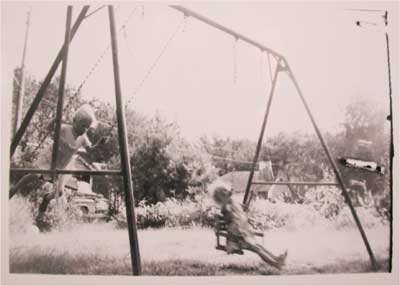
Always in the swing of things, Cheryl Unruh learned about living big while a 4-year-old in Pawnee Rock. [April 26] "Like many of you, I'm a Kansas lifer, a child of the prairie. "Kansas is the land where I was born, where I struggled for balance after Dad removed the training wheels from my bicycle." So wrote my sister, Cheryl Unruh, last year as she began "What Kansas Knows," a column that appeared in the Emporia Gazette. Cheryl, born in Larned, raised in Pawnee Rock, resident of Emporia, formally educated in Great Bend and Lawrence and informally educated all over the state, is every bit a Kansan. 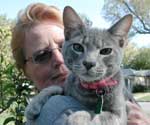 She's a poet, published several times in the Christian Science Monitor. She runs a respected website, FlyoverPeople.net, and sometimes reads her columns over the Kansas Public Radio network. She has been a teacher, a hospice worker, a sheriff's dispatcher. I've tried over the years to get her to move out of Emporia -- away from the blood-burning beef-packing plant -- to Austin or Wichita or Dallas or Eagle River, where I've lived, but she'll have none of it. She's as solidly Kansan as post rock. Cheryl is home. She is Kansas. She is the moral post we can hold on to when the winds blow. She's a free thinker, a rabble rouser, and yet a "calming voice," as our cousin Laramie's wife, Michelle, called her. Cheryl is good family. She's the kind of sister you may not always want -- she might just tell you to do it yourself -- but the kind you always need. She's helpful, considerate, funny, and generous. She has long wanted a pinata for her birthday party, but she passed it up this year when she and her husband bought one instead for her father-in-law to whack on his 88th birthday a week before hers. This past weekend the Kansas Press Association recognized Cheryl's understanding of Kansas with an honorable-mention award for her column writing. "What Kansas Knows" was one of the three columns in her entry; the two others were "Driving Lessons," about learning to drive from Mom, and "Seed Potatoes," about the legacy of small acts of kindness. Cheryl celebrates her birthday Thursday. Please, say "Happy Birthday." The great circles of life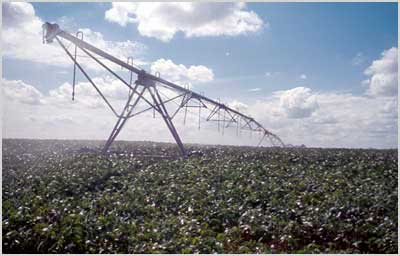
A center-pivot irrigation system at work. (KU photo) [April 24] My beloved Dodge Coronet 440 had a busy life. It was the family car for years, and then Mom and Dad passed it down so I could drive to school. It once went 95 mph. It had a push-button transmission and a rear-speaker reverberator that twanged when the car hit a bump. One fall day, in a fit of high-school motorheadity, I removed the air filter cover so the engine could breathe more (not better, just more). The carburetor caught fire outside Carris' store. A couple of months later, as I was warming the car up before taking my sister to school, a short circuit ignited the dashboard and turned the Coronet into a smoking blue box on wheels. The interior was ruined, the wiring was destroyed, and sweet Cheryl was left standing there with her saxophone case. The following spring, Dad sold the car to Glen Lakin, a real mechanic. He cleaned up the motor and put it to good use pumping irrigation water on a farm near Pawnee Rock. That seemed like a big thing: my car's engine became a helpful part of the food chain. Back in those days, I sometimes helped trundle irrigation pipes from one field to its neighbor. I topped lots of milo in irrigated fields. But now I'm just astonished at how much irrigation there is, and I wonder where all the water's coming from. I grant you that I don't depend on a family or corporate farm for my income. I gladly eat the food that comes from the fields. In fact, I might never have raised the issue had I not flown between Denver and Wichita a year ago and looked down on section after section after section of center-pivot circles. We've all seen -- and now rarely notice -- the giant aluminum critters that water the fields and make sure you and I have wheat for our bread, milo for our beef and corn for our high-fructose corn syrup. It's a pretty sight. The 30,000-foot view is more eye-catching. See for yourself: Open a Google Maps browser window and type "coolidge, ks" into the search box. Click on the "Hybrid" view when the maps or satellite photos come up. Look for green circles around Coolidge, where the Arkansas River enters Kansas. Zoom out and in for the big picture. Follow the river downstream to stockyard-heavy Garden City and Dodge City, then on to Pawnee Rock, and drift south from there. Who knew Kansas could be so green? It's bad for the aquifer, I guess, but good for many people. So, anytime you're driving south of town, keep your eyes open for a 1968 V-8 sitting atop a well. With so many pumps going, there's a chance my old friend is still helping relieve world hunger. [You can find out more about Kansas water policy from the Kansas Water Office.] Where are you grounded?[April 23] Earth Day on Saturday got me thinking about exactly which part of Earth means the most to me. This past winter newspapers ran a story about how kids lost their connection to their home or their hometown when they don't get out and play. That makes sense. A kid who digs in the yard or plants a garden or plows a field is going to have deeper feelings than a kid whose environment is created by PlayStation 2. Here's my list of where I feel closest to Mother Earth: • The Pawnee Rock cemetery, where I clipped and mowed grass and dug graves (can't get much closer to the Earth than that). • A draw in my grandparents' farm northwest of Pawnee Rock. A vein of clay amid the sandstone provided days of hands-on pleasure for my sister, Cheryl; my cousin Mary; and me. • A stone patio shaded by hickory trees at my mom's parents' place outside of Fayetteville, Arkansas. • Our own back yard, where Cheryl and I played in the garden amid the cannas and corn and tomatoes. • A place near the Point, where Ash Creek flows into the Arkansas River. On a camping trip there, I walked through the ghostly downed cottonwoods and felt as if I were at home. Where are you grounded? Attracted to track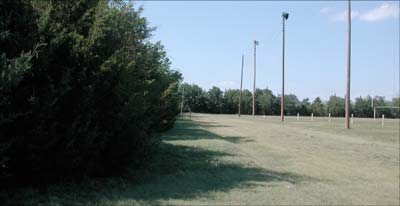 The Pawnee Rock school track, a quarter-mile dirt oval, is now grown over with grass. [April 22] When it's spring, the thoughts of students in junior and senior high turn not to romance (that's a full-year preoccupation) but to track. In the last year of Pawnee Rock High School, being on the track team was the best way to stay in the good graces of Gary Romeiser, the track, basketball and football coach. Mr. Romeiser yelled a lot. He brought to our town invective and fury that made the harshest peanut-gallery coaches nod in appreciation. In the summer before my freshman year, I took driver's ed from Mr. Romeiser in Larned. As I was the only Pawnee Rock kid in his class, he drove me over and back. He was pleasant enough, I guess, but not a conversationalist with a skinny kid who would never be a football player. "You should never drive with one hand. Never do it. It's not safe," he told the class one day. "Now, I can do it, because I'm ambidextrous." Mr. Romeiser, who was also the shop and health teacher, ran us hard in track practice and expected mental toughness. His attitude was leavened by the cheerful Benny Brown, the art teacher and assistant coach. Let me say now that I wasn't a track star, although I had dreams of being Jim Ryun. Ricky Batchman and Carl Epperson could sprint like the wind. Alan Mead was the pole vaulter. Other guys ran relays, sped over hurdles, threw javelins and got the medals and the girls. I was the guy Mr. Romeiser penciled in to run the two-mile race because, well, the team needed someone in that race in a track meet at Skyline, a rural school west of Pratt. As I had never run two miles before, I didn't have a clue about tactics. So I just ran. It's an eight-lap race. I was still a half-lap from the finish when the first three runners crossed the line, and all of a sudden a few Pawnee Rock guys were running alongside me inside the track, yelling, "Sprint, sprint!" I did, and I outkicked a runner named Castenada from Lewis. I finished in 11 minutes, 17 seconds, not too far behind Marty Loving's Pawnee Rock school record. I collected two points for our team. "Good race, Unruh," Mr. Romeiser said. And he went about his business. My dad had driven one of the two buses to Skyline. It was the only time in high school he ever saw me race. "You did good, Leon," he said. And he shook my hand. The mysterious tunnel
A view of the old tree nursery and, in the distance, the building where the tunnel might have led. [April 21] One of the enduring mysteries of Pawnee Rock has been the tunnel that ran from a disused basement in the "forest" to an old brick building on Barton Avenue. What happened to the building over the basement? Why was the tunnel built? Who used it? Did it even exist? The forest, of course, was the old tree nursery on the south side of Santa Fe Avenue west of the Christian Church and fire siren. Once the source of the trees that shaded Pawnee Rock but soon overgrown, it has been a Goosebumps/Hardy Boys-type playground for generations. I think it used to belong to Art Sayler. (Now the forest has been cleared out.) There were rumors that the older Tutak boys had checked out the basement for a tunnel. Once or twice, I crept up on the rim of the basement and looked in at the rubble. I didn't see any tunnel, but there was a dark place at the back of the basement that could have been an entrance. And there was the other mystery of the basement -- what happened to the house and the people who lived in it? The building at the purported other end of the tunnel has long been a ruin; anyone who ventured in was -- and is -- in danger of stepping on nails or getting a bashed-in head from falling bricks. We hoped the tunnel existed. We needed the idea of a mystery and maybe no one wanted to prove it didn't exist. Or maybe we were all just a little scared that it did and was the home of terrible subterranean secrets. To my knowledge, no one who went through the tunnel lived to tell about it. Walking on the ledge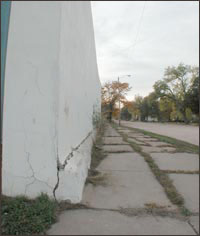 [April 20] We all try to lead balanced lives, even when nobody's looking. But were our lives ever more balanced than when we -- admit it, you did it too -- walked along the ledge on the north side of the former grocery store / current American Legion hall? Maybe you made it all the way from the sidewalk to the back of the building. Perhaps you made it to your personal landmark -- a sapling that grew out of the sidewalk joints, a scratch in the whitewash. You know, that ledge used to look a lot wider. The next time you're downtown, step up. (No one will be watching.) I heard the train a-comin'[April 19] When we were sixth-graders in the late 1960s, a special Santa Fe passenger train toted a bunch of us to Dodge City for a Saturday of rooting around Front Street and Boot Hill. 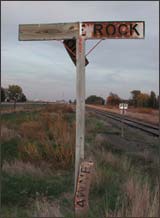 Tickets cost a pittance. I think most of the expense was picked up by Lions Clubs along the 75-mile route: Great Bend, Pawnee Rock, Larned, Garfield, Kinsley. We knew it was a special day as we lined up on the bricks at the depot. For some of us, it was our first long trip without our folks. We bounced around in the drizzle and cheered when we heard the westbound's horn at the last crossing east of town. Our parents had told us there was no more regular passenger service left on the line, which in the 1870s brought out many of the town's original families and later took its commodities to the big city. We had heard our parents talk -- even the freight business was almost gone; the salt plant wasn't far from being closed and we'd soon be down to wheat cars. So we lived it up on the train. We loaded our bellies with popcorn and taffy and soft drinks, and there were kids from other towns aboard too. I'm sure I wasn't the only one who ran his fingers over the upholstery, the window fittings, the cables, hoping to commit every sensation to memory. These days, I take our sons on rail trips once or twice a year. Where we live, the railroad stays profitable pulling hopper cars loaded with coal and passenger cars packed with tourists. Nine-year-old Sam dreams of being an Alaska Railroad engineer. Now, these paragraphs aren't written with tears for a railroad way of life I never knew. Instead, they're a reminder that what we take as a certainty can always change. And although I say the trips are for the boys, they're for me too. I don't want to let any memories slip through my fingers. In the mailbox[April 18] Sunday's piece about the Bible readings in school brought a laugh to Arizona mail carrier Jared Smith, son of Virgil and Joan Smith. I made one small change in his e-mail so that current fourth-graders can read this: "What I remember the most about Mrs. Fry's Bible reading is the first time the word 'a--' came up in the text. Can you imagine her reaction when one of my classmates (won't name anyone because I can't remember exactly who) burst out in obnoxious laughter? Needless to say, he was led unceremoniously to the chalkboard where his nose remained in a circle during the remainder of the reading!" He added later: "Most of our grade school teachers probably did pray for us once in a while, and I'm okay with that!" Don Ross, formerly of Cuniffe Street and now of Dodge City, wrote to give a name to one of the players in a photo of the 1943-44 Pawnee Rock basketball team. He identified the player standing next to Coach Edgar as Jack Woelk. (Go to the gallery.) Don also suggests that the two remaining unidentified players are Billy and Bobby Wycoff, but he's not 100 percent sure. Teaching by The Book[April 16] Let's see who remembers the daily Bible readings by our fourth-grade teacher, Virginia Fry. 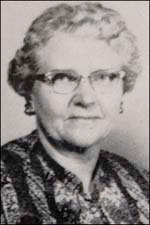 She started the Pawnee Rock school year with Genesis, reading chapter by chapter from the black-covered book kept in her drawer. Seated at our desks after lunch, we listened and did not interrupt. Mrs. Fry wasn't the only teacher who warned us of eternal detention in those days when the no-prayer court ruling was becoming news. Glenda Franklin, our first-grade teacher, was evangelically inclined ("Listen to Rex Humbard," she suggested) and taught a Sunday School class at the Bergthal Mennonite Church north of town. Earl Alvin Schmidt, our eighth-grade teacher and a farmer, also taught on the Lord's Day at the Mennonite Church. He was encouraging and invited us to think critically, but he too was a reason to behave during the week. We kids didn't want to be reported to God, of course, but we also lived in near-mortal fear of being the subject of an object lesson or, worse, of being prayed for publicly. Other teachers may have also answered the call in other churches. They all taught us schoolkids well, and I remember them as kind people: Aletha Loving, kindergarten; Louise Wilhite, second grade; Mildred Dunavan, third grade; Beulah White, fifth grade; and Elva Jean Latas, sixth grade. Seventh-grade teachers included Bernard Williams and Mr. Cisco. Shiela Sutton Schmidt, the elementary music teacher at school and a fine soloist in church, especially led by Christian example. I wish I had gotten to know Mrs. Franklin and Mrs. Fry better as a high-schooler or adult, but the high school was closed after my freshman year and I rarely saw them again. Occasionally I bucked bales at Mrs. Schmidt's Rock House farm northeast of town, and after Harold died and she moved north I was given the family mailbox. I did run into Earl Alvin Schmidt now and then; he and wife Maxlyn met you with a smile and you left with one too. Sometimes I wondered whether Mrs. Fry ever had any hope of influencing our fourth-grade minds and souls. Considering kids at that age, maybe she just needed a daily reminder of the heavenly reward held for grade-school teachers. Song of Pawnee Rock[April 15] The country band Rascal Flatts has a new CD with a song called "Ellsworth," which describes a woman's romantic memories of life in that town. My sister, Cheryl, pointed me toward her friend Peg Britton, who lives in Ellsworth and has some interesting details about the song in the blog on her KansasPrairie.net site. Well, Pawnee Rock, where's our song? Pawnee Rock: The most feared place on the Santa Fe Trail. Halfway from Missouri to Santa Fe. Indian battleground. Kit Carson was here. The original "In Cold Blood" movie included footage from Pawnee Rock. The school was closed and the students were bused away. It's a farm town. Wind. Heat. Rain. Stone. A dried-up river. Ash Creek. Wagon ruts. Train tracks. The salt plant closed. Lots of truck traffic. There's an Easter pageant on the Rock (odd-numbered years). Jobs lost and gotten, and families lost and found. Don't tell me there's nothing to sing about. Where's our song? Now, I can't carry a tune in a bucket, so I write. But someone from Pawnee Rock must be able to sing. You all have stories -- tell them! Tell them in song and make yourself rich and feel good for getting it out of your system. Sing your song. Life in the cemetery[April 14] With Easter around the corner, this seems like a good day to visit the Pawnee Rock cemetery. It was around 1970 that the township appropriated the money to plant cedars around the eastern seven acres of the cemetery -- the new side. My dad, Elgie Unruh, was the sexton then, and I, his teenage son, was his chief helper for mowing, digging graves and hanging chain-link fences. Working in the morning and evening to avoid the heat, Dad dug holes in the tan soil, and we planted dozens of cedar saplings. Don't be misled by the happy term "saplings." These were prickly, sticky-sapped little trees, destined for a hardscrabble life of leaning against a dry wind under a beating sun. We made each tree stand straight as we mounded the dirt around its tiny trunk. After filling endless five-gallon buckets with our hose at home or with the red hand pump in the center section, we drove around our "garden" and poured water gently on the mounds. As the dirt settled, we poured more water and straighted the trunks. We did it again every week until the little trees had a foothold on life. Today, when I visit the cemetery in the evening, I like to walk down the streets and say hello to all the folks I remember from when I clipped around their headstones and say goodbye to the more recently passed. I look for graves I helped dig and cover, and I admire the peonies and cactuses if they're blooming. Now, especially, I like to walk along the eastern edge of the cemetery and listen to the meadowlarks and the wind as it blows through the strong trees that once were knee-high to a 15-year-old. And I imagine that if they can turn out so well, there's hope for all of us. Free coffee ahead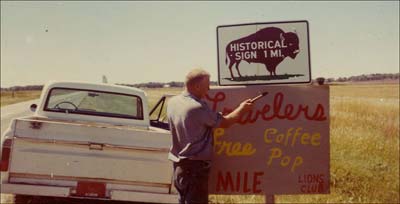 [April 13] Remember when U.S. 56 was a regular two-lane highway without shoulders and the drivers were nice enough that a kid could ride a bike there safely, if not wisely? Yep, those were the days when the Pawnee Rock Lions Club trotted out the good stuff on big holiday weekends. The members set up a coffee stop in the historical marker pullout, and they sometimes even put their big golden lion on a trailer or pickup to show it off. The guys seemed to have a good time. These were talkers -- toss a subject such as the weather, mileage, crops or sports into the air, and they'd have it dissected before it hit the ground -- and they found a lot of kindred spirits in the kind of people who'd pull off for coffee. In this photo, Tom Flick gives westbound travelers a heads-up that caffeine was available just on the other side of town. Pawnee Rock (the park) is on the right of the scene. I suspect that Elgie Unruh made the shot in the 1970s. Marshal Bill's bumper[April 11] Bill Unruh put up with a lot as Pawnee Rock's marshal. In addition to dealing with the annual Halloween hooliganism of the 1970s, he kept an eye on stop-sign runners, drunks and general hoods and thugs. I don't know whether he kept his handgun loaded or just kept a round in his shirt pocket, but I don't think I ever heard of him having to use force. And Marshal Bill was not a big guy, which may have worked to his advantage. He never presented a threat beyond legal action. Bill sometimes was caught in cat-and-mouse games as teens committed some minor mischief and then hid with their car lights off, only to pop up again with more tomfoolery as soon as the marshal had passed. Yet he stayed on the job for several years, I think, longer than many of the marshals Pawnee Rock has employed to protect itself. Bill was a good guy and ethical. One time a friend and I tailed Bill around town, driving perfectly legally, until he had had enough. He pulled over and waved us to the curb, demanding to know what we were up to. Thinking fast, I pointed out that his pickup had a pipe bumper that covered his license tag. A week later, his bumper was cut out to reveal his tag. He never mentioned it to me, nor I to him. But I never bothered him after that, and he was always cordial. He was an upstanding guy. At least the prairie part sounds nice . . .[April 9] "Pawnee Rock springs like a huge wart from the green prairie and stands totally inaccessible and alone." -- Matt Field, journalist, 1839, quoted on a University of Missouri Kansas City web page. Field's description of our Santa Fe Trail landmark is not the most flattering view of Pawnee Rock, but it's always nice to be remembered. And that was before the town was here, so we shouldn't take it too personally. From atop Pawnee Rock, we can still see patches of the green prairie, and we can imagine a lot more. Mama told me not to come [April 7] KFRM, KANS, KVGB, KSAL -- the voice of Kansas. You wanted music, you got country. Loretta Lynn, Dolly Parton and Porter Wagoner. That's where our dial was set in the 1960s and early 1970s. It was AM radio, and it was seasoned on the hour and half-hour with obituaries, Scripture of the day, farm reports and other by-products of rural life. There were rebels, though, under the elms of Pawnee Rock. And I don't mean people who cozied up to the Carpenters. Dean Lakin listened to rock on KOMA, broadcast from Oklahoma City. I was upstairs at Dean's house the first time I heard KOMA and Dean began singing along to "Rocky Raccoon" -- there was a guy who obviously had music experience! When I went home for supper, I was sure Mom would notice something about me was different. 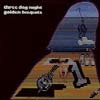 Bill Dirks had several acid-rock albums and a good stereo at his house near Dundee, and sometimes after church on Sunday evening we'd gather in his room in the dark and listen to music and burn strawberry incense and gaze at his bead curtain and wonder how black-light posters worked. Yeah, we were rebels. We sang with a twang, but we sang rock 'n' roll. 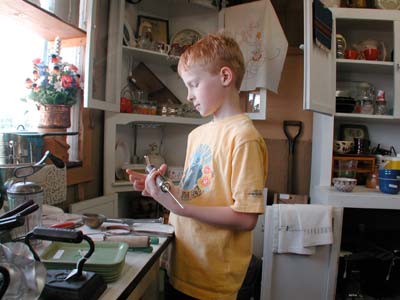 My son Sam meets the kitchen of the past in the Santa Fe Mercantile in Pawnee Rock. The Time Before Plastic[April 5] "Know what that is?" Dad would say. "That's a drive gear from a thresher." "We used to butcher hogs on this table," Grandma Unruh would say over a plate of fried chicken. "We'd kill them in the yard." Even for us kids in the 1950s and 1960s, when party lines still existed and TV was black-and-white, such talk was a little antique-ish. Years later, we see what our folks were doing: trying to whip some sense of lineage into us and enjoy their own memories. So we insist that our already curious kids hold the thresher gear, the sadiron, the metal baster, the black-and-white photo, the typewriter and the dial telephone. Maybe, we think, the physical presence of these objects will help the kids imagine -- even understand -- what life was like in the 1920s, the 1940s, the 1960s. Our family now has Grandma's oak table in the dining room. I have one of Dad's pocketknives in my drawer, and my great-grandfather Sam Schultz's china cabinet is at my back. There's a thresher gear around here someplace. I guess I'm still a kid, too. Why I love Ida Deckert[April 3] It was a horrible season for the Pawnee Rock Warriors football team. We had lost the first two games of the season, followed by a 30-0 loss to the giants from McCracken on our home field. And suddenly it was the last game of my seventh-grade season, and we didn't have much chance of winning this game either no matter how hard we banged our padded little bodies into one another on that chilly Thursday evening. The game started, and it went well for the other team. Then from the home sideline -- in one of those coincidental moments when every voice but one is silent -- cheerleader Ida Deckert yelled: "Give us something to be proud of!" Well. There it was. It seemed kind of selfish for the crowd to need something to be proud of, and I remember feeling resentful. We were playing as hard and as well as we could. Did any of the other Warriors hear Ida's plea? Did we give the faithful crowd of parents anything to be proud of? We tried, but we lost the game. But the game wasn't just for two dozen scrawny kids on a green 80-yard field. On those nights, we were the town itself. You know what? That shout by Ida Deckert has stayed with me as well as anything I learned in the school building. It's a pep talk we should all give ourselves now and then. Royal purple[April 1] How about those Wildcats! With a roster half full of Kansans, the K-State women's team won the National Invitation Tournament championship Friday night in Manhattan. It was K-State 77, Marquette 65. Wichita State's grab for glory ended after only two games with the loss to George Mason, but at least the Shockers get to be a footnote to George Mason's unexpected run to the men's NCAA Final Four. The KU women did well in the NIT, and for the KU men, there's always next year. Again. So much for basketball. Let's put on our Royals caps and play baseball. August | July | June | May | April | March Copyright 2006 Leon Unruh |
Sell itAdvertise here to an audience that's already interested in Pawnee Rock: Or tell someone happy birthday. Advertise on PawneeRock.org. |
|
|